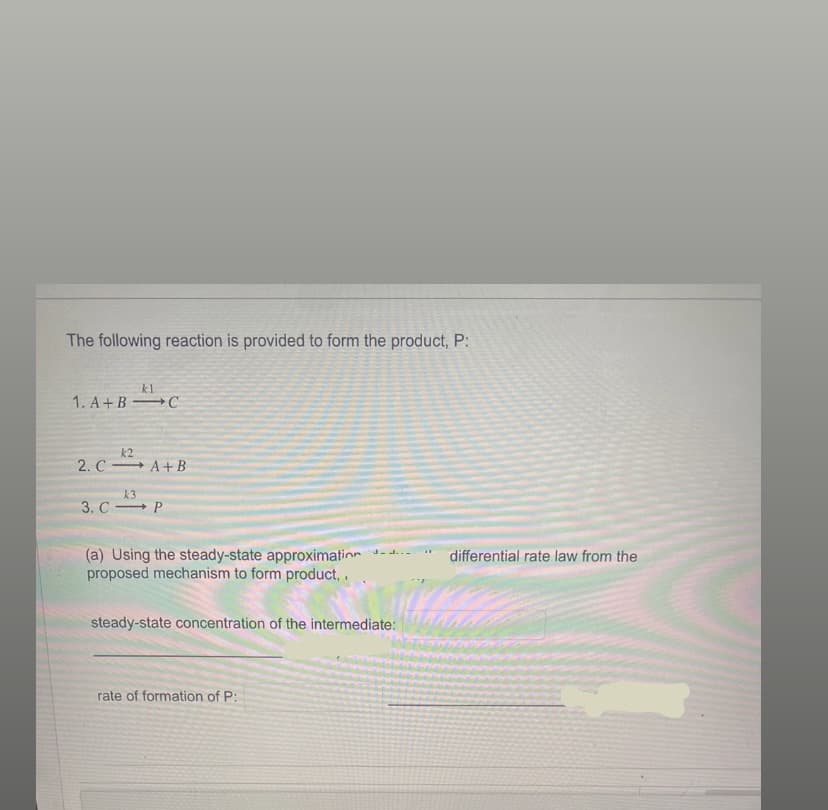k2 2. CA+B k3 3. C P (a) Using the steady-state approximation - proposed mechanism to form product, . steady-state concentration of the intermediate: rate of formation of P: differential rate law from the
k2 2. CA+B k3 3. C P (a) Using the steady-state approximation - proposed mechanism to form product, . steady-state concentration of the intermediate: rate of formation of P: differential rate law from the
Physical Chemistry
2nd Edition
ISBN:9781133958437
Author:Ball, David W. (david Warren), BAER, Tomas
Publisher:Ball, David W. (david Warren), BAER, Tomas
Chapter20: Kinetics
Section: Chapter Questions
Problem 20.72E
Related questions
Question

Transcribed Image Text:The following reaction is provided to form the product, P:
kl
1. A+B C
k2
2. CA+B
k3
3. CP
(a) Using the steady-state approximation -
proposed mechanism to form product, .
steady-state concentration of the intermediate:
rate of formation of P:
differential rate law from the
![The following reaction is provided to form the product, P:
kl
1. A+B C
k2
2. C A+ B
k3
3. CP
(b) Using the accuracy of steady-state approximation for the intermediate, find the
rate of change of A and show that it is first order with respect to both A and B also
second-order overall.
rate of change of A: [A]_](/v2/_next/image?url=https%3A%2F%2Fcontent.bartleby.com%2Fqna-images%2Fquestion%2Fb4299bab-cfe6-4df1-82fa-bdefd18a2ba9%2F644b4b72-9bc9-428a-ae22-d2d5cee2c596%2F747kqyt_processed.jpeg&w=3840&q=75)
Transcribed Image Text:The following reaction is provided to form the product, P:
kl
1. A+B C
k2
2. C A+ B
k3
3. CP
(b) Using the accuracy of steady-state approximation for the intermediate, find the
rate of change of A and show that it is first order with respect to both A and B also
second-order overall.
rate of change of A: [A]_
Expert Solution
This question has been solved!
Explore an expertly crafted, step-by-step solution for a thorough understanding of key concepts.
This is a popular solution!
Trending now
This is a popular solution!
Step by step
Solved in 2 steps with 2 images

Knowledge Booster
Learn more about
Need a deep-dive on the concept behind this application? Look no further. Learn more about this topic, chemistry and related others by exploring similar questions and additional content below.Recommended textbooks for you

Physical Chemistry
Chemistry
ISBN:
9781133958437
Author:
Ball, David W. (david Warren), BAER, Tomas
Publisher:
Wadsworth Cengage Learning,

Chemistry for Engineering Students
Chemistry
ISBN:
9781337398909
Author:
Lawrence S. Brown, Tom Holme
Publisher:
Cengage Learning

Principles of Modern Chemistry
Chemistry
ISBN:
9781305079113
Author:
David W. Oxtoby, H. Pat Gillis, Laurie J. Butler
Publisher:
Cengage Learning

Physical Chemistry
Chemistry
ISBN:
9781133958437
Author:
Ball, David W. (david Warren), BAER, Tomas
Publisher:
Wadsworth Cengage Learning,

Chemistry for Engineering Students
Chemistry
ISBN:
9781337398909
Author:
Lawrence S. Brown, Tom Holme
Publisher:
Cengage Learning

Principles of Modern Chemistry
Chemistry
ISBN:
9781305079113
Author:
David W. Oxtoby, H. Pat Gillis, Laurie J. Butler
Publisher:
Cengage Learning

Chemistry: Principles and Practice
Chemistry
ISBN:
9780534420123
Author:
Daniel L. Reger, Scott R. Goode, David W. Ball, Edward Mercer
Publisher:
Cengage Learning

Chemistry: Principles and Reactions
Chemistry
ISBN:
9781305079373
Author:
William L. Masterton, Cecile N. Hurley
Publisher:
Cengage Learning
